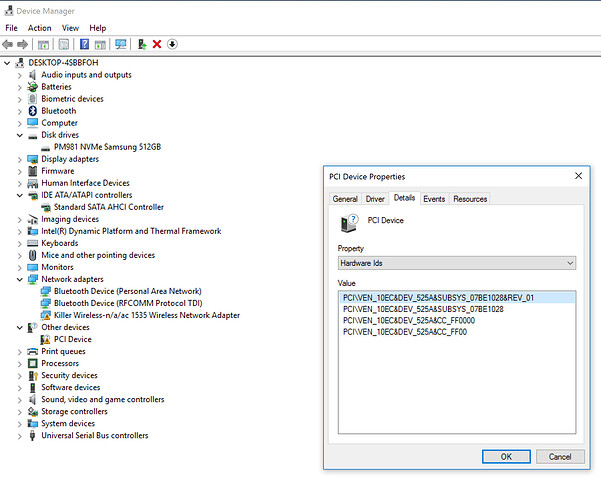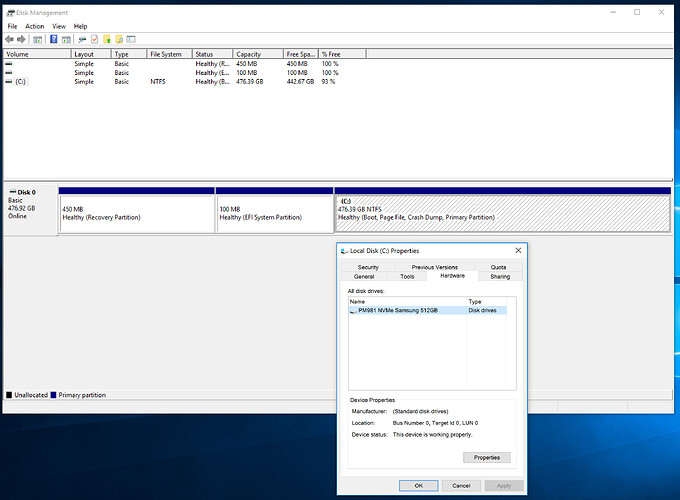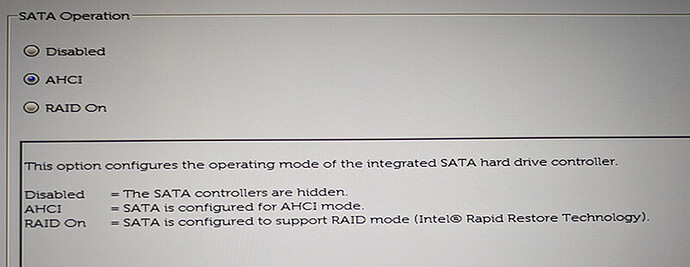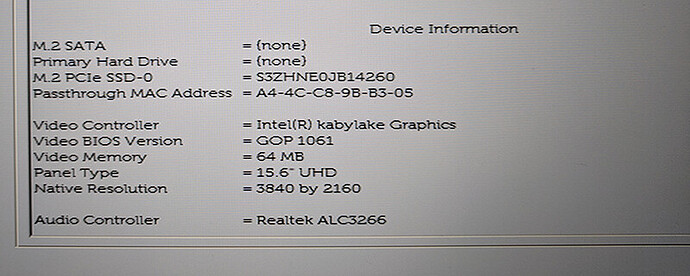Your welcome. Btw i can help you for further test if you want. Also wanted to tell you that I had to back to the Microsoft Ahci, because i was getting insane latencies on the storport.sys reported by last version of Latency Mon, over 2500us
EDIT by Fernando: Unneeded parts of the fully quoted post removed (to save space and for a better readability)
@Fernando :
Thanks for the reply.
Apparently I was distracted enough to forget about installing motherboard’s SATA RAID Controller. The only controller I had installed was this Standard NVM Express Controller:
PCI\VEN_1CC2&DEV_0340&SUBSYS_10931B4B&REV_00
PCI\VEN_1CC2&DEV_0340&SUBSYS_10931B4B
PCI\VEN_1CC2&DEV_0340&CC_010802
PCI\VEN_1CC2&DEV_0340&CC_0108

After that I looked for drivers from MSI and AMD, but they require amd catalyst and don’t detect it, so I’ll try a clean install. My real challenge still is doing a direct installation (or reinstallation) of windows 7, instead of cloning it from another drive.
@HotLobster :
On board of your ADATA XPG SX9000 NVMe SSD is a Marvell NVMe Controller 88SS1093, but Marvell hasn’t (yet) released an NVMe driver, which natively supports this Controller.
Consequence: Only the generic MS NVMe driver is able to detect and to manage this specific Marvell NVMe Controller.
Since Win7 doesn’t have any MS in-box NVMe driver, you will have to integrate the related MS NVMe Hotfix. For details please look >here<.
I have Windows 10 x64 on my laptop and this current driver version installed 11.6.0.1030 for the ‘Intel 7 Series Chipset Family SATA AHCI Controller’
Hardware ID’s:
PCI\VEN_8086&DEV_1E03&SUBSYS_10BE1462&REV_04
PCI\VEN_8086&DEV_1E03&SUBSYS_10BE1462
PCI\VEN_8086&DEV_1E03&CC_010601
PCI\VEN_8086&DEV_1E03&CC_0106
Is there a better driver available that I would benefit from using?
@Dime_Baggins :
Within >this< thread you can find the answer to your question.
At the bottom of the start post is a table with Intel AHCI driver versions, which I recommend to use with Intel 7-Series Chipset Mobile systems.
Alternatively you can use the generic MS AHCI driver, which is very good as well.
I have a general question about manual installation of various pure drivers (for example: AHCI, IME, USB, LAN) by using their *.inf files instead of full instalation (with "bloatware") from official *.exe files.
I think such installations are not registered in "Control Panel" -> "Uninstall a program" table. Now what about any updates? If I manually install new *.inf version of specific driver then do all files from previous version get removed / replaced? Or there will be any leftovers?
@Lex :
The drivers do not belong to the category “Software”. That is why you don’t see an entry within the Control Panel “Add/remove software” area, if you have installed the “pure” drivers and didn’t run the EXE file of a complete “Drivers & Software Set”.
Vice versa the drivers, which are part of a “Drivers & Software Set”, usually remain installed and stay in-use after having uninstalled the related Software from within the Control Panel.
It is the latter and this makes sense, because otherwise the related device would be unsupported (worst case: you would not even be able to boot into your OS) after having recovered a previous system by having chosen the “Restore Point” option.
So the previously used, but now replaced drivers and the related INF files stay within the Windows directory, but will neither be used by the OS nor take much space. On the other hand you have the advantage, that you can return to a specific previously used driver very easily by doing a right-click onto the related device and choosing the options “Update driver” > “Browse my computer…” > “Let me pick…”. Provided, that the option “Show compatible devices” is checked, all your previously used drivers resp. the related device names are listed and can be chosen just by clicking onto it (no navigation to any specific driver location is necessary).
@Fernando : So they stay pure till next time of update only. ![]() Small joke here.
Small joke here. ![]()
Thank you very much for explanation!
Hi Fernando,
I was wondering if you could help me out with my issue. I ran a clean install on an XPS 15 9560 in AHCI mode with a Samsung PM981 SSD.
When I attempted to install the Samsung NVMe driver v2.3 I received the following error message:
"Samsung NVM Express Device is not connected. Connect the device and try again."
After some searching, I found myself in this post and I believe I need to update my AHCI drivers before I can install the Samsung PM981, however, I am not sure which to choose.
The following is what my computer displayed under HardwareIDs:
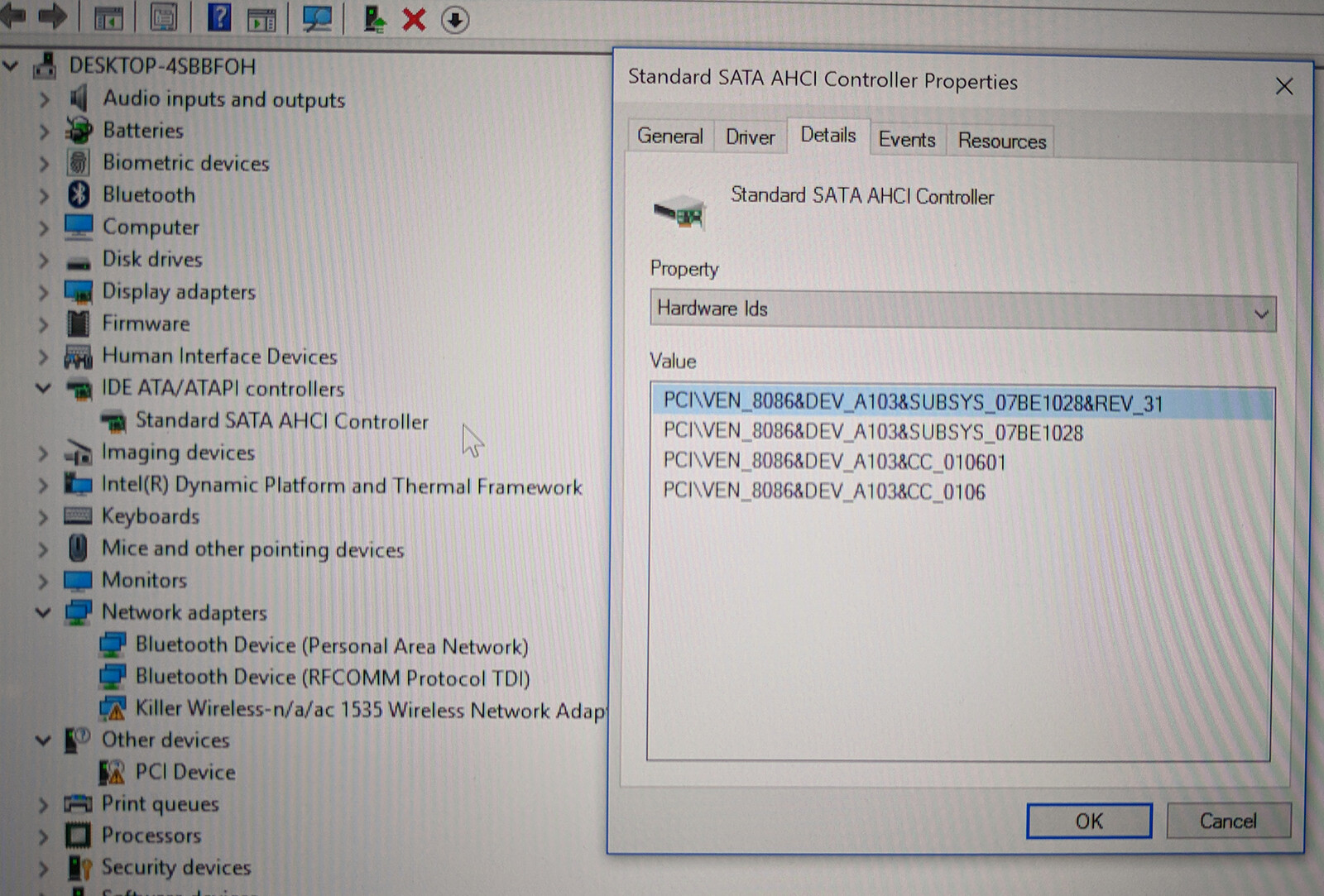
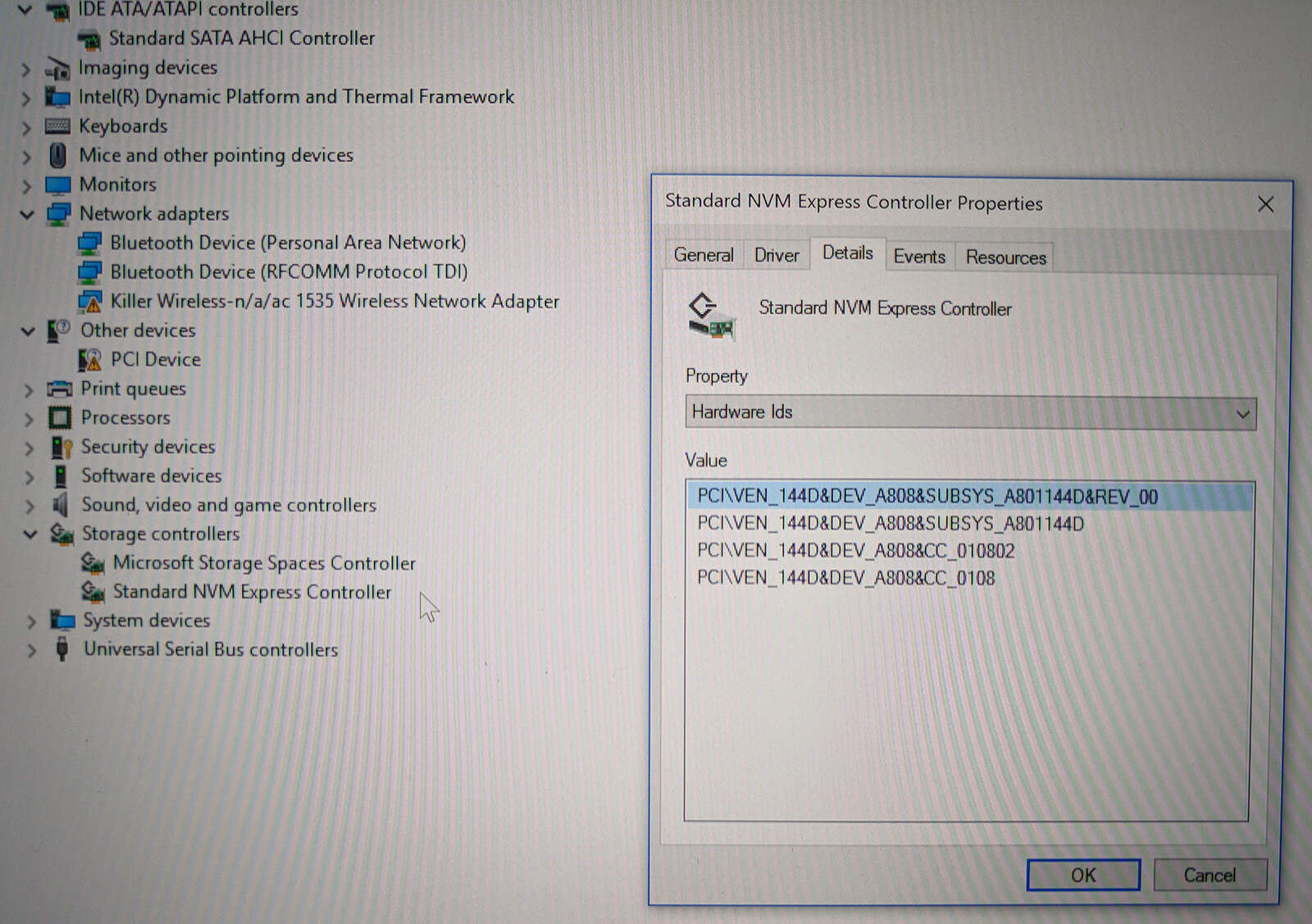
I would truly appreciate any assistance. Also, after I manage to update these drivers without causing a fire, should I add them to the Group Policy to protect them from Windows Update? Thank you in advance and for this post.
@drmindriot :
Welcome to the Win-RAID Forum!
You cannot install any OS (Win10?) onto an NVMe SSD in AHCI mode. AHCI and NVMe are completely different interfaces.
Where and how did you try to install the Samsung NVMe driver?
Additional questions:
1. Which are the HardwareIDs of the listed, but yellow flagged “PCI Device”?
2. What does the Disk Management show? Please post a screenshot of it.
Regards
Dieter (alias Fernando)
Thank you! Pleasure to be here.
I received a link from Dell to download the Samsung_NVM_Express_Driver_2.3.exe driver.
Here it is:
Disk management:
Based on the guides I found on how to do a clean install on the Dell 9560 I was instructed to put the computer into AHCI mode in Bios. I attached a screenshots of where I did that and also another screenshot of the device information.
The computer has Win10 installed on it. Thank you so much for your help.
EDIT by Fernando: Unneeded part of the quoted post removed and reformatted the post structure (to save space and for a better readability)
@drmindriot :
Thanks for having posted the requested details.
Here is my comment:
1. The NVMe Controller, which is located within your Samsung NVMe SSD, cannot be managed by your on-board Intel SATA Controller, because it uses the NVMe interface and not the AHCI one.
2. If you want to change or update the currently in-use NVMe driver, you have to expand the “Storage Controllers” section of the Device Manager, to do a right-click onto the listed NVMe Controller and to choose the “Update driver” option.
3. The officially released Samsung NVMe drivers do not support the NVMe Controllers of SSD, which are only used by the “Original Equipment Manufacturer” (OEMs) and not available for the public.
4. The “Unknown device” is a Realtek PCIE CardReader. Just search for the related driver and install it.
Hey, I am just curious. Are you saying that my system specifically cannot take advantage of NVMe or I do not have it configured properly? Would it be better for me to do a fresh install with Raid On?
Thank you for all your help!
No, your NVMe SSD is obviously working fine with the Win10 in-box NVMe driver and there is no reason to change anything regarding your current configuration.
Since there is no disk drive connected to your on-board Intel SATA ports, the related BIOS settings regarding the SATA mode (IDE/AHCI/RAID) are irrelevant.
Thank you sir, you are a gentleman, and a scholar. ![]()
Hi
We ordered many Dell Optiplex 5050 small factor and they come with Toshiba XG5 M.2 SSD (model number: KXG50ZNV512G). The OS can be cloned to the SSD, but the performance is not good. Similar to other members here, I couldn’t find any driver for Toshiba XG5, not even on the OCZ or Toshiba web site.
Is there any way we can modify the XG4 driver for it?
The HardwareID is PCI\VEN_1179&DEV_0116&SUBSYS_00011179&REV_00
Thanks
Raymond Mui
@ramram49 :
Hello Raymond,
welcome to the Win-RAID Forum!
Although I generally do not modify and sign drivers upon request, I have just added the HardwareIDs of the new Toshiba XG5 NVMe Controller DEV_0116 to the INF files of the already existing mod+signed 32/64bit OCZ/Toshiba NVMe drivers v1.2.126.843 and gave these drivers a new digital Win-RAID CA signature.
Notes:
- Since I do not know, whether the NVMe Controller of the new XG5 SSD generation will work with the old NVMe drivers, which were designed for much older Toshiba NVMe SSD models, it has to be tested by you or someone else. Please give me a feedback rearding the test results.
- Before you are going to install any of my mod+signed drivers, you have to import the Certificate (to assure the trustability of a Win-RAID CA signature).
- A mod+signed storage driver, which has been integrated into a Windows OS image or loaded during the OS installation, may not be accepted by the OS Setup, because the trustability of the digital signature cannot be approved during the early stage of the OS installation.
By the way: I have moved your post into this already existing thread, where I am offering the original and the mod+signed OCZ/Toshiba NVMe drivers.
Good luck!
@all:
Update of the start post
Changelog:
-
OCZ/Toshiba NVMe drivers:
- customized: mod+signed 32/64bit OCZ/Toshiba NVMe drivers v1.2.126.843 dated 05/13/2016, mod+signed by me at 01/18/2018 Notes:
These freshly mod+signed drivers additionally do support the Toshiba XG5 SSDs and their NVMe Controllers with the DeviceID DEV_0116.
Good luck with these freshly mod+signed OCZ/Toshiba NVMe drivers!
Dieter (alias Fernando)
Hi Fernando,
Thanks. Is it just adding XG5 to the original .inf? Or something else need to do (besides the certifying process)? Just want to learn more.
Raymond
Yes!
hey Fernando, nice list btw, just curious is there any microsoft NVMe drivers? for server 2012 or windows 8.
reason i asked because I recently migrating OS disk from SATA SSD to Samsung NVMe SSD, then now onto 900p Optane SSD. when I first went from SATA to Samsung NVMe SSD, I had a lot of issue with inaccessible boot device message and turns out that of course my SATA OS couldn’t recognize NVMe SSDs without driver. so I installed the NVMe driver to my OS while it was on SATA, created an image with samsung NVME driver, restore it onto Samsung NVME SSD and boot worked.
now I am getting same error booting off 900p. I installed intel NVMe drivers onto my OS which is now on Samsung NVMe SSD, which it now recognizes 900p as a disk. I then create an image of that, restore onto 900p, however this time did not work.
im been asking around and some say intel and samsung nvme drivers have lots of issue, best if I use MS inbox NVMe driver which was made native server 2012 R2 or windows 8.1, but im 2012/windows 8, no driver… pls help.
